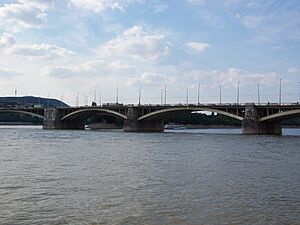Hubert Pál Álgyay facts for kids
Hubert Pál Álgyay (Szeged, 6 June 1894 – Budapest, 27 August 1945) was an important Hungarian engineer and teacher. He is best known for designing bridges and helping to shape the transport system in Hungary.
Early Life and Education
Hubert Álgyay was born in the city of Szeged, Hungary, on June 6, 1894. He loved to learn and decided to study engineering. He went to the Budapest Technical University, a famous school for engineers.
In 1924, he finished his studies. That same year, he became an assistant teacher, helping students learn about building bridges. He also completed a special research project to earn his doctorate degree.
Building Bridges in Hungary
In 1926, Álgyay started working for the government's Ministry of Transport. This department was in charge of roads, railways, and bridges. He quickly showed how talented he was.
By 1934, he became the head of the bridge building department. This meant he was in charge of all new bridge projects in the country. Later, he even became a very important government official for transport, called a state secretary.
One of his most famous projects was designing the Petőfi Bridge in Budapest. This bridge was built between 1933 and 1937. He also helped make the Margaret Bridge wider, so more people and cars could use it easily. From 1935 to 1937, he was also the president of a special group that looked after important government buildings in the capital city.
Teaching and Legacy
Hubert Álgyay loved to share his knowledge. From 1937, he taught at the Technical University again, this time as the main teacher for bridge building. He also wrote many important books and papers about engineering. These writings helped other engineers learn new ways to build strong and safe structures.
Álgyay passed away in Budapest on August 27, 1945. He left behind a legacy of impressive bridges and a reputation as a dedicated teacher and engineer.


